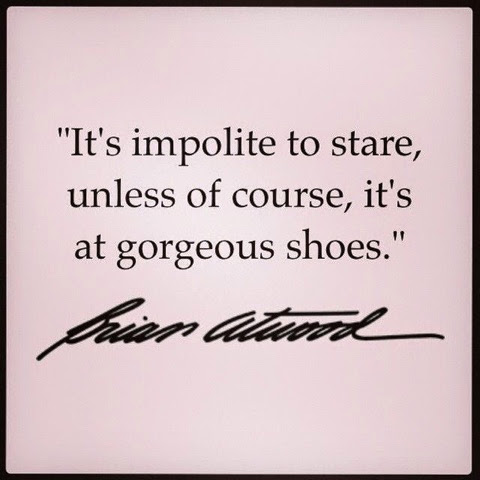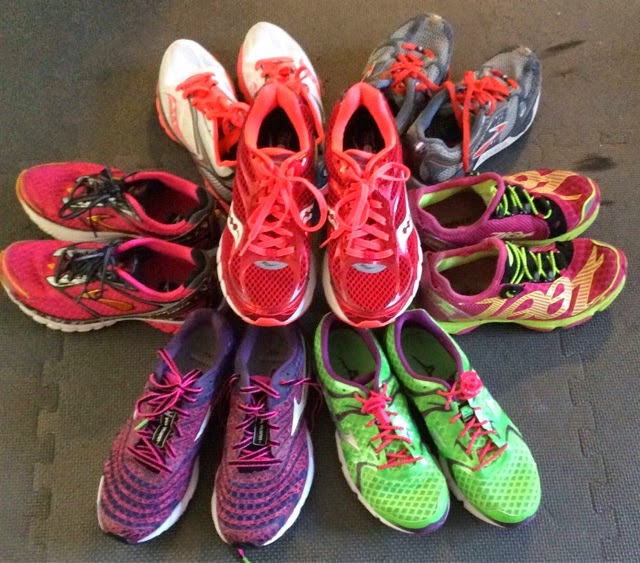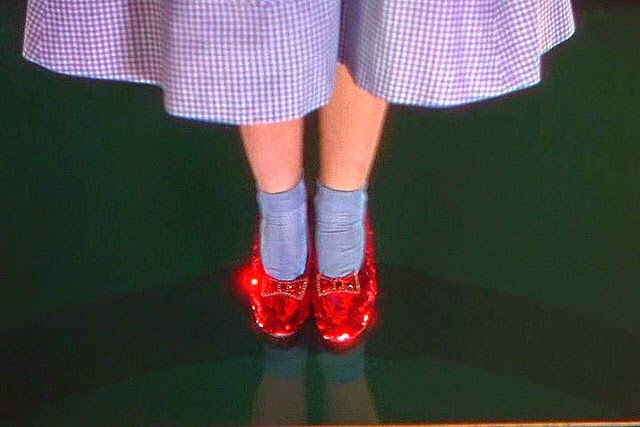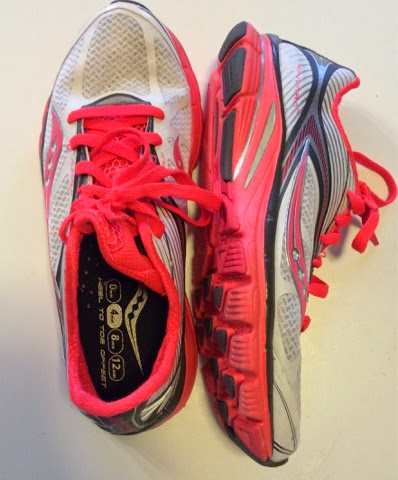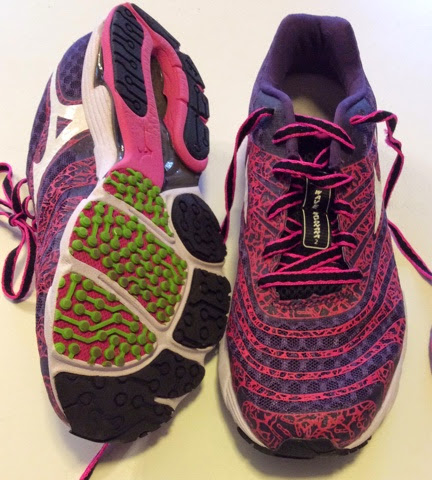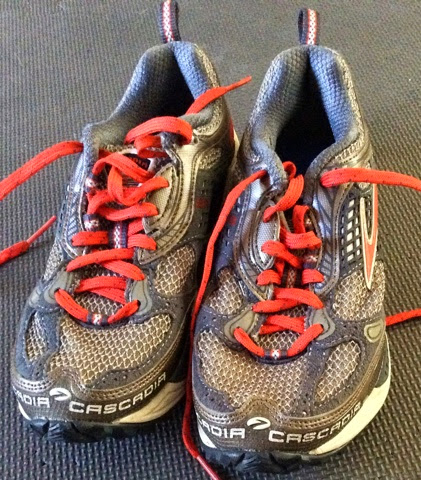I’ve started (ok continue to be) obsessing about shoes and want to talk about what I’ve learned as I’ve built my personal stable of run shoes.
I now mostly run long and steady in a new pair of beautiful bright red pair of Saucony Ride 7s in Berry and I’m really happy with them. They have shiny red plastic that almost makes them appear to sparkle. I call them my “Ruby Red Slippers” because they are in a stand out shade of red. They are beautiful and I consider them to be a “magical catalyst” but that’s a story for another day (I promise).
Yet, it’s certainly not all about the aesthetics in run shoes and not all shoes are magical. Fit, comfort and support are the more important features in a run shoe and when those things are harmoniously balanced in a shoe it can feel darn near supernatural to run! I wore Brooks Ghosts as my “go to” running shoe for years. However, every year models change and this year’s model, the Ghost 7s felt different. They completely revamped the shock absorption material in the shoe to make it lighter this year. Reviewers raved about it, but my feet did not. So, now I’m in the Sauconys as my primary shoe.
I used to “invest” in heels or boots and wild sandals but since I’m paranoid about my feet getting hurt again after my sexy heels triggered plantar fasciitis in 2011 I had to move that ingrained shoe love to beautiful run shoes. This shift in shoe closet composition happened with the foot injuries and also as I’ve become more deeply passionate about running. Fast shoes are sexy to me now. Luckily, there’s practical justification for a collection of this nature.
Shoes are amazing but it can be a maze trying to figure out which shoe to use. My answer? Start a shoe rotation.
Despite an injury history, my feet have remained healthy (KNOCK ON WOOD please) recently. One of the many things I have implemented with my running program is a “shoe rotation.” I have one core shoe I use for the majority of my runs, but I will mix it up and switch shoes with in each week depending on the type of run I will be doing. Formerly, I did all my running in one shoe.
I enjoy having an arsenal of shoes to select from depending on the type of run training on tap. I also suspect its helpful to me specifically given my over-use injury history. I think there’s some protection if I put my feet in variety of shoes during the week. I feel like it might distribute the constant load I place on my feet to different little micromuscles. I personally suspect there would be tiny gait or foot strike pattern differences between the various sneakers when I’m running. These differences might spread the load of impact to different tiny little foot tissues and muscles. I notice some shoes offer me a better feel for the ground and might help me develop my most efficient form with out even thinking about it. Other shoes offer incredible comfort and support where I can (and do) just go for miles in them. Some kicks also just feel really fast and fun.
I do not recommend going out and buying four or five pairs of run shoes all at once. In fact I’m not suggesting switching shoes is even necessary to do as one core shoe can be versatile enough to do the job for all runs. I just like having shoe cycle within each week. To start a rotation, it could be as easy as two pairs of similar shoes from different manufacturers. You could buy a new pair before the old one is on its way out.
SHOP
You could pick your shoes based on which shoe your favorite world class famous runner had on their fast feet when they won a big event. Well, you could do that but your needs will likely differ!
The best way to determine what shoes will best fit YOUR needs is to go to a running shoe store and have an expert look at your form and match you up. I bring the socks I like to run in and my old shoes so they can see the “wear pattern.” The spots that wear most will reveal where the foot is striking the ground and what “kind” of runner you are for a shoe match. In Richmond, I have been to both Lucky Foot and Three Sports with really good service, expertise and results in matching me up with the right shoe. Run in the shoes. Ask questions. Plan to stay a while so the search is relaxing. I also like to find deals just before the “latest” model is released each year. Once I have a brand/type and series I am confident in, I commit to it & look online for deals to replace it with the same model. My shoes last longer when I’m not running in the same pair every day so I’m not buying many at once. I will just own many at once for parallel use. The life of the shoe depends on how many miles you put into them. Oh, and to avoid injury, I never wear shoes that are completely worn out. Our muscles need all the support we can give them in shoes that are literally taking the load off our feet. I donate my run shoes when it’s time to replace them as many run shops have donation boxes for gently used sneakers.
SHOE CATEGORY
There are many kinds of running shoes, or sneakers as those of us with northern roots like to call them. There are stability/guidance shoes for over-pronators who turn their feet in during the gait cycle. There are neutral cushioned durable trainers that can withstand high mileage and are a good all around shoe. You can also add to your collection over time and buy all kinds of kicks: delicate race flats, track shoes, lightweight performance trainers, trail shoes and even elastic last tri-specific shoes with holes for water to leak out the bottom for races.
SHOE WEIGHT
At the run track a few months ago, I was ogling a beautiful pair of a teammate’s speedy featherweight Addidas. I actually asked her if I could hold them and she let me! Lighter shoes means less weight to carry and even an ounce or so off the feet can reduce the energy cost to the body during running. That wieght savings helps you move faster. Now, that does not mean it is a good idea to go out and buy the flimsiest shoe one can find and use them for all runs. As run distance increases, energy costs could go up with a lighter shoe if there is not enough support. That lack of cushion and support can cause the body’s muscles to fatigue faster. There is a point of diminishing returns and that balanced spot will be different for everyone (and every distance for the person) depending on mechanics, body type, experience and other individual characteristics.
HEEL DROP & CUSHION
If that was not complex enough, there is also the heel drop to consider. That is the offset between the heel and the toe heights. ( Here is a good read on “heel drop”) There are minimalist shoes with zero drop. These shoes came out with the the “barefoot running” trend that was prevalent when I first entered the sport 7 or so years ago. Some believe this promotes a more natural foot strike. Others think it causes injury. There are models on the other end of the spectrum boasting a 10mm heel drop that some (such as Zoot) report is best and ideal for run to bike transitions. There is a big range of offsets out there as many companies offer a wide variety in their product lines. Saucony even prints the drop in the insole of their shoe to help shoppers navigate the shoe maze better.
The latest trend is the opposite of minimalist shoes in the form of maximal cushioned shoes.
Overview of the Maximal Cushioned Shoe trend. I don’t have experience with these but they are supposed to help reduce the fatigue on the body from running stress.
ORTHODICS
I’ve had some foot injuries so I do have an orthodic. I do not wear my orthodics 100% of the time anymore now that my feet seem to be healthy and durable/strong (thanks toe towel curls and ridiculous toe yoga) but I do like them for long runs or if I ever notice any slight arch pain. These inserts were custom molded to my feet by Dr. McMahon. Since I started using orthodics, I switched from the Brooks Adrenaline (stability with motion control features to correct overpronation during the run) to the Brooks Ghosts (neutral) a few years ago. A corrective orthodic plus a motion control shoe was over-correcting. Now, I’ve found I do not need a stability shoe, even without the orthodic.
Here’s my running show arsenal:
Saucony Ride 7. 8.5 oz and 8mm drop. Neutral cushioning. High mileage durable “go to” daily trainer. It’s lightweight & considering the class of shoe and very fun for long and easy runs. These will see the most miles this year as I train for the ironman. They are my magical ruby red slippers & “home” for me is definitely running in them!
The slippers have magical transportation powers that supersedes humans ability on foot. Isn’t these what we want in a run shoe? Performance.
Zoot Ultra Tempo: 8.5 oz 10mm drop. Fast transitions. Some motion control. Tri specific. Designed for tri races including long course. Seems heavy for its class but I’ve done plenty of tris in these including my first ever overall win and they do not feel chunky. They are the fastest in transition with a shoe horn feel for getting the shoe on the foot easily. These are about two years old.
Saucony Kinvara 5: 4mm drop. 6.7 oz. This is the closest thing I have to minimalist shoes. It’s supposed to promote a natural run gait without a drastic zero drop. They are a transitional shoe to the minimalist moment. I got these a couple years ago but harshly blamed a pre-stress fracture on them last year. Looking back I think I ran too many short races & 5ks too soon & close together after my return to running comeback. They are widely popular and they are fun to run in. I crushed my last 5k in these babies.
Mizuno Sayonara 2s. 6.3 oz. 10mm drop. My favorite shoe EVER! The first version was great and I find no notable difference in feel yet this updated model is lighter. They are in the performance neutral category but have far more support than others in this generalized grouping. Lightweight with a lot of support. I ran 18 miles straight in the Sayonara 1s last year and felt adequately supported. They feel perfectly fast & light for running at the track too. I think they are best for tempo runs. The performance and versatility is exceptional. I also wore them to a community service work event once and they look beautiful receiving compliments based on their appearance alone from non-runners. I’m in love with them. Love. Love.
Mizuno Hitogamis: My friend, Dane (bike mechanic) suggested these to me last year. At 6.2 oz they are my lightest shoe. They boast a “low slung ride” yet have the nice 9mm drop which is closer to what I’ve been accustomed to. I can truly feel and respond to the ground best & most comfortably when I am running fast in these shoes. They are good for fast training days or races. They are stable given the weight. If you put the sides together they look like a Japanese mask. I added the pink transition laces The insides are soft enough for sock less this summer. Green for shamrock half marathon!
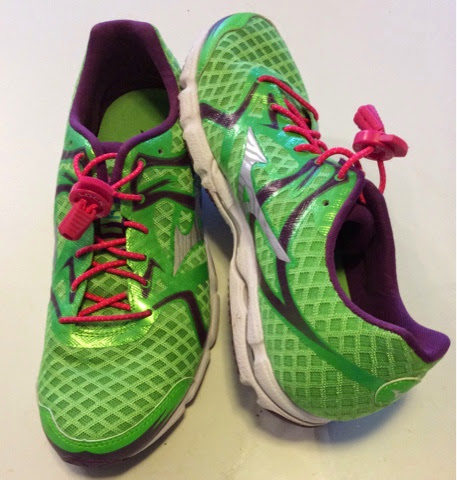
Brooks Cascadia. These are my trail runners. They are grippy yet light on the trails. I feel very secure in these in the rougher or slippery terrain.
All runners should love shoes. I appreciate what our shoes do for our complex, shock absorbing feet when we put them through the paces. They are stunning and they are performance driving tools.


